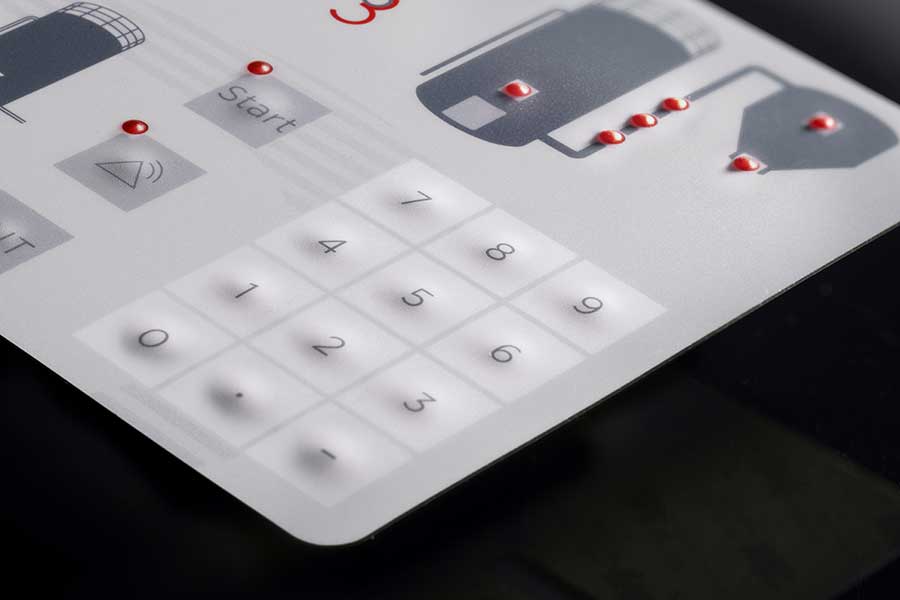Membrane Switches: A Essential Component in Personalized Control Panels
Why Membrane Switches Over Are Vital for Resilient Control Systems
Membrane buttons play an essential duty in guaranteeing the longevity and integrity of control systems throughout numerous industries. Their one-of-a-kind building and construction enables them to endure tough environmental elements such as humidity, temperature level extremes, and physical wear. This resilience not just extends the life expectancy of the systems they offer but additionally reduces upkeep demands. As we explore the diverse benefits of membrane layer buttons, it becomes apparent that their significance goes beyond mere performance, affecting user experience and operational effectiveness. What more ramifications do these qualities hold for the future of control system design?
Introduction of Membrane Switches
Membrane layer buttons are functional and trustworthy components generally utilized in various electronic control systems. These buttons include numerous layers, including a visuals overlay, a spacer layer, and a published circuit layer. The graphic overlay gives both useful and aesthetic style, while the spacer layer makes sure that the switches are activated just when pressed. The published circuit layer has conductive traces that complete an electric circuit when the membrane is pushed, allowing the tool to respond to individual inputs.
Membrane buttons are usually preferred in applications calling for a compact and light-weight design, making them suitable for portable tools, medical devices, and commercial equipment. They can be customized to meet particular user demands and can include various functions such as backlighting, responsive responses, and multiple colors. Membrane layer switches are immune to dirt, wetness, and contaminants, making them ideal for atmospheres where sturdiness is vital.
Advantages of Toughness
In numerous applications, the longevity of membrane changes offers considerable advantages that boost their overall efficiency and integrity. These switches are developed to hold up against severe atmospheres, making them perfect for usage popular problems such as high moisture, extreme temperature levels, and direct exposure to chemicals. Their robust building and construction helps to avoid damages from physical influence, making sure lasting performance and reducing the requirement for frequent substitutes.
Additionally, membrane buttons are resistant to deterioration, which is important in applications where regular communication takes place. This sturdiness equates to lower maintenance expenses, as companies gain from reduced downtime and fewer service disruptions. The encapsulated style of membrane layer switches safeguards internal components from dirt and dampness ingress, further contributing to their life-span (membrane switch).
An additional advantage is their capability to keep constant performance gradually. With a high tolerance for mechanical stress, these buttons protect their responsive feedback and electric stability, making certain customer contentment. Inevitably, the sturdiness of membrane layer switches not just boosts functional effectiveness yet likewise promotes self-confidence in their reliability, making them a favored selection for control systems throughout different markets.
Applications in Different Industries
Sturdy control systems using membrane layer switches locate extensive applications throughout a series of industries, each gaining from the distinct characteristics these switches offer. In the clinical market, membrane layer switches are crucial for devices such as patient monitors and analysis equipment, where dependability and simplicity of cleansing are paramount. Their resistance anonymous to wetness and pollutants ensures they keep functionality in sterile settings.
The automobile market leverages membrane switches for dashboard controls and infomercial systems, where they give sleek, inconspicuous user interfaces that boost individual experience. These switches are additionally made to withstand harsh conditions, including exposure to extreme temperatures and vibrations.
In commercial settings, membrane layer buttons are commonly used in equipment control panels, offering tactile responses and durability needed for high-usage applications. Their ability to resist chemicals makes them suitable for producing settings where spills and pollutants are regular.

Consumer electronics, such as cooking area home appliances and remote controls, likewise use membrane layer buttons for their adaptability and cost-effectiveness. Overall, the flexibility and durable nature of membrane layer changes make them indispensable throughout different markets, making certain reliable procedure and long life in control systems.
Design and Aesthetic Allure
While performance is paramount, the layout and aesthetic charm of control systems outfitted with membrane layer buttons play a critical role in user involvement and general experience (membrane switch). The visual design of these switches can considerably influence customer assumption and communication. A properly designed membrane button boosts the beauty of the tool, making it much more attractive to individuals and promoting a connection in between the user and the product
Membrane changes provide a good deal of flexibility in style, permitting manufacturers to personalize graphics, shades, and textures to straighten with brand identification and item visual appeals. Using lively shades basics and unique patterns can attract attention, while tactile feedback can strengthen the user's interaction with the device. Furthermore, the capacity to integrate LED indicators and backlighting into the membrane layer button style provides both useful and aesthetic advantages, boosting exposure and functionality in various atmospheres.

Enhancing Customer Experience

Additionally, membrane layer buttons can be tailored to integrate visual user interfaces, boosting use by offering information in a clear and intuitive fashion (membrane switch). This customization can include icons, labels, and color coding that guide users via complicated capabilities easily. In addition, their versatility allows for assimilation in numerous settings, ensuring consistent performance whether in commercial equipment or customer electronic devices
The toughness of membrane switches additionally plays a crucial role in user experience. By holding up against rough conditions and extended usage, these buttons decrease the possibility of system failures, thus advertising dependability and user self-confidence. Inevitably, the calculated use membrane layer switches over not just raises functionality yet additionally dramatically enhances individual interaction with control systems, making them an important component in modern-day style.
Final Thought
